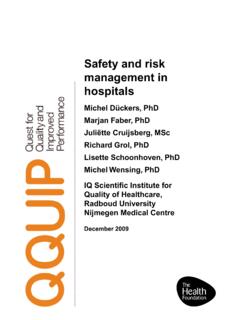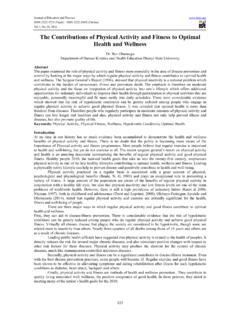Transcription of Practice Guide to Person Centred Clinical Risk Assessment
1 1 Practice Guide to Person Centred Clinical Risk Assessment June 2014 Prepared by Friederike Gadow & Vivienne Riches, Centre for Disability Studies & The University of Sydney for NSW Department of Family & Community Services, Ageing, Disability and Home Care 2 Table of Contents Acknowledgments .. 2 Disclaimer .. 3 Key Definitions .. 4 1. Introduction .. 8 2. Principles of A Positive Approach to Clinical Risk Assessment & Management .. 13 3. Process of Person Centred Clinical Risk Assessment .. 16 General Instructions .. 16 Specific Instructions .. 21 (1) The Person What is important to and important for the Person ? .. 21 (2) Goals and Dreams How do the risk management strategies enable the persons hope and dreams.
2 23 (3) Status Quo Where are we now? .. 24 (4) History What have we tried and learned? .. 27 (5) Action Plan What shall we do next? .. 28 (6) Monitor, Review and Evaluate .. 31 4. References .. 32 5. Appendices - Templates and resources .. 39 Sample Report Template .. 40 Forensic Risk Assessment .. 43 Mental health Concerns .. 44 Person Centred Tools .. 48 List of Figures and Tables Figure 1: Person Centred Approach to Clinical Risk Assessment .. 20 Table 1: Decision making agreement, adapted from Lunt & Bassett ( ) .. 29 Table 2: Forensic Clinical risk Assessment instruments .. 45 Table 3: Mental health risk Assessment concerns .. 46 Acknowledgments In developing these practical guidelines, the authors would like to thank the Statewide Behaviour Intervention Service (SBIS), ADHC.
3 3 Disclaimer The guidelines presented in this document are intended to promote good Practice in the Person Centred Assessment and safeguarding of risks . They may be adopted in whole, or adapted in part to meet service provider needs. The authors would like to acknowledge that in enabling risk, even with the best quality Clinical Practice , procedures and safeguards in place, incidents will inevitably occur. For this reason, neither the authors, nor the Centre for Disability Studies, can accept liability in respect of any claims for personal and/or property damage, or any financial losses, sustained following the occurrence of incidents in disability services. 4 Key Definitions Bio-psycho-social model Is an approach positing that biological, psychological (which entails thoughts, emotions, and behaviors), and social factors influence the development and maintenance of behaviours, including behaviours of concern.
4 Complex Support Needs Individuals with complex support needs are those: who are experiencing (or are at risk of experiencing) multiple and interrelated conditions or factors which contribute to an intensity of support need. Examples of these conditions or factors include: multiple disabilities, dual diagnosis ( mental health and disability), significant medical conditions or significant deteriorating health conditions, behaviours involving harm to self or harm to others, alcohol and/or drug issues, and issues relating to past experience of trauma or neglect in addition to having an intellectual disability AND/OR who are experiencing (or are at risk of experiencing) one or more situational factors that impacts on the complexity of their support needs or the ability of their natural supports to meet their needs.
5 Examples of situational factors include a lack of natural supports, family/carer stress, a breakdown in carer arrangements, young people who are leaving care, involvement in the criminal justice or forensic system, and multi-agency involvement in supporting an individual AND who challenge the service system s capacity to respond to their support needs because of its structure, organisation or resourcing. Dignity of risk Dignity of risk refers to a commitment to each Person s right to control his or her own life, including both good and bad experiences. (Parsons, Cocks & Williamson, 2009, p. 37) The ADHC Behaviour Support Policy (2012) provides additional detail: The principle that everyday risks are a part of life and the freedom to make choices, take risks and experience the consequences, good and bad, contributes to personal dignity.
6 5 Duty of care Duty of care can be physical, emotional, financial or social; it is the obligation to take reasonable care to make sure you or another Person are not harmed. Reasonable means the degree of care that could be expected from a competent and skilled Person in the particular job. Neglect is the failure to maintain duty of care (ADHC Code of Conduct, 2012). In relation to behaviour support, Duty of Care is the obligation incumbent on disability workers and supervisors in their regular professional dealings with Service Users [individuals] to ensure that all reasonable measures are taken to prevent harm which may be reasonably foreseen. The standard of care appropriate for any given situation may depend on the level of a Person s skill.
7 For example, the standard of proficiency expected from a qualified nurse will be higher than that required from a worker without special skills. Negligence is a failure to exercise this Duty of Care (ADHC Behaviour Support Policy, 2012). Multi disciplinary team approach A multidisciplinary team approach in providing disability support can be described as a partnership among professionals of different disciplines inside and outside the disability sector and the community with the aim of providing quality continuous, comprehensive and efficient services. Person Centred planning Person Centred planning is an approach to social justice and inclusion originally developed in supporting people with learning disabilities (Stirk & Sanderson, 2012, p.)
8 24). Additionally, A Person - Centred approach is one which seeks to gather information about a Service User s [individuals] lifestyle, skills, relationships, preferences, aspirations, and other significant characteristics, in order to provide a holistic framework in which appropriate, respectful and meaningful behaviour supports may be developed (ADHC Behaviour Support Policy, 2012). Person Centred thinking Person Centred thinking is founded in Person Centred planning. Person Centred thinking employs a range of Person Centred thinking tools that help to determine the following: How does the Person want to live and be supported? How can people have more choice and control in their lives?
9 What is our role in delivering what is important to people and how they want to be supported? How 6 well are we supporting people in the way they want to live? How can we work together to keep what is working and change what is not working? How can we keep learning about the Person and what we need to provide the best support? (Sanderson & Lewis, 2011) Protective factors Protective factors enhance the likelihood of positive outcomes and lessen the likelihood of negative consequences from exposure to risk (Jessor, Turbin & Costa, 1998). They can be defined as "influences that modify, ameliorate or alter a Person 's response to some environmental hazard that predisposes [that Person ] to a maladaptive outcome".
10 Research strongly suggests that protective factors may offset the effects of exposure to risk factors . Protective factors encompass and include social bonding to family, school, community and peers; healthy beliefs and clear standards for behaviour; as well as individual characteristics. Reasonable risk taking Reasonable risk taking means that staff are using sound judgement and are expected to show that they have carefully thought through what might happen and acted responsibly in line with this (Methven, 2012). Risk Risk means possibility of danger as well as actual danger ( health and Safety at Work Act 1974 S1 1974/143). Risk Assessment A gathering of information and analysis of the potential outcomes of identified behaviours.





